Carl E. Olson's Blog, page 195
September 18, 2012
The State and the Sacred
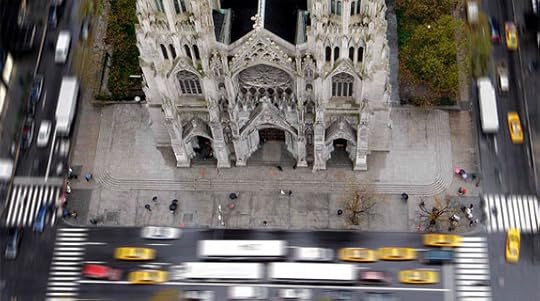
The State and the Sacred | James Kalb | Catholic World Report
Today there is no god higher than Caesar, and Caesar has identified himself with the principle of individual choice and thus with the divinity of the individual will.
Every
functional society is based on a system of common understandings about man, the
world, and the common good. Otherwise those who take part in it won’t be able
to cooperate effectively in the network of complex, enduring, and sometimes
very demanding undertakings through which they carry on the life of the
society.
Such
understandings can exist even though they aren’t held by everyone, or in their
entirety by many people at all. It’s only necessary that people who run things
make them basic to how they cooperate, and the people at large go along with
the arrangement. Thus, a secular society doesn’t have to be one in which most
people oppose religion in public life. It just has to be one in which influential
people agree religion doesn’t belong there, and find ways to enforce the
agreement.
In the early ’60s
most people didn’t like the school prayer decisions, which pushed religion out
of the public schools. But the decisions stuck, because people who ran things
liked them, and it’s hard for the people at large to resist what higher-ups
settle on as proper. Since that time the same view of what is proper has meant
a continuing trend toward secularism, and many Catholics have come to view the
resulting kind of society as entirely consistent with their faith. Government
is carried on without reference to religion, but political entanglements are
corrupting, the Church is free to carry out her mission in civil society, and
in any event American public religion was basically Protestant.
So why aren’t
things better now, and why isn’t what we have enough?
Spousal Love in Conjugal Spirituality
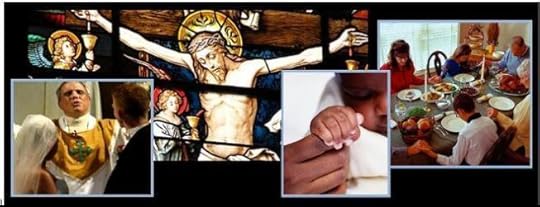
Spousal Love in Conjugal Spirituality | Christopher J. Stravitsch | Homiletic & Pastoral Review
Spousal union is sacramental because it makes visible the invisible reality of God’s spousal love for his people.
Our Catholic faith is lived through an array of spiritual traditions.
While each observes the same theological truths, the Church is enriched
by the different emphases within each tradition. The same is true of
conjugal spirituality. Married couples, who give rise to the Domestic
Church, are as varied as the schools of spirituality. While Catholic
marriages are built upon a common theological foundation, each couple’s
spirituality may emphasize certain aspects of their vocation to which
they are particularly drawn, and in which they can live quite well.
This paper explores perspectives of conjugal spirituality that cultivate
reverence for, and understanding of, spousal love. First, a masculine
perspective is presented, through which husbands are tutored in spousal
love as they contemplate Christ, the Divine Bridegroom, whose agape is poured out from the cross. A feminine perspective approaches Mary’s fiat as
a model for wives, who are called to image the Church as they receive
and respond to spousal love. Next, a liturgical analogy is presented as
a means for fostering reverence for what is sacred in conjugal union.
Finally, contraception is critiqued as an antithesis to conjugal
spirituality, while conceiving new life through the chaste practice of
natural family planning is lauded as a noble fulfillment of it.
Christ’s Agape Tutors Husbands in Spousal Love
“Precisely because Christ’s divine love is the love of a
Bridegroom, it is the model and pattern of all human love, men’s love in
particular.” 1
Both the crucifixion and conjugal union consist in pouring out love for
the bride; therefore, husbands can be invited to contemplatively place
themselves at the foot of the cross in order to learn the meaning of
spousal love.
In Deus Caritas Est, Pope Benedict XVI invites us to reflect on the pierced side of Christ as a starting point for contemplating love. He writes:
His death on the Cross is the culmination of that turning
of God against himself in which he gives himself in order to raise man
up and save him. This is love in its most radical form. By
contemplating the pierced side of Christ (cf. 19:37), we can
understand…“God is love” (1 Jn 4:8). It is there that this truth can be
contemplated. It is from there that our definition of love must begin.
In this contemplation the Christian discovers the path along which his
life and love must move. 2
The beauty of the crucifixion is that it communicates the total
outpouring of Christ’s love for his Bride. On the “marriage bed” of the
cross, 3
Jesus exclaims, “It is consummated” (Jn 19:30). Fr. Raniero
Cantalamessa, Preacher to the Papal Household, describes the union of
Christ and the Church as coming about, not in a “bed of pleasures,” but
“‘in blood,’ on the cross.” 4
The consummative love of the Divine Bridegroom is not satisfied in
stopping short of death, of suffering, or of withholding anything;
rather, Christ is completely poured out as a libation. The Gospel of
John recounts that “when they came to Jesus and saw that he was already
dead, they did not break his legs, but one soldier thrust his lance into
his side, and immediately blood and water flowed out” (Jn 19:33-34).
As we stand beneath the crucified Christ and “look upon him whom they
have pierced” (Jn 19:37), we are bathed in the blood and water that
pours forth from his wounded side.
September 17, 2012
"Theosis and the Role of the Laity"
The past June I had the pleasure and honor of being one of six presenters at the annual Orientale Lumen conference, the 17th such conference, which was held in Washington, D.C.:
From June 18-21, 2012, the Society of St. John Chrysostom, Eastern Churches Journal,
Eastern Christian Publications, and the Orientale Lumen Foundation held
a popular and scholarly conference for lay men, lay women, and clergy
entitled Orientale Lumen XVI. The theme for the conference, held at the
Washington Retreat House in Washington, D.C., was “Theology of the
Laity.”
The conference provided an opportunity for Roman Catholics, Eastern
Orthodox, Eastern Catholics, and Oriental Orthodox to gather, discuss,
and learn about their respective traditions. It included presentations
by scholars and theologians, liturgical celebrations of many varieties,
and opportunities for everyone to learn from each other and participate
in a “dialogue of love and understanding.”
The conference is rather unique, as it is not part of an official ecumenical dialogue, but is very much "grass roots" in the best sense of the term. Two of the longtime, regular presenters are Metropolitan Kallistos of Diokleia (Orthodox) Ecumenical Patriarchate of Constantinople, from Oxford, England, one of the leading Orthodox theologians of the past half century, and Archimandrite Robert Taft, SJ (Greek Catholic), the leading scholar of Byzantine liturgy, who taught for many years at the Pontifical Oriental Institute before recently retiring. It was wonderful to meet both men, as well as the other presenters, including Fr. Gregory Gresko, who is the chaplain at the Blessed John Paul II Shrine, right next to the Washington Retreat Center, where the conference was held.
The talks are online and can all be accessed on the Ancient Faith Radio website. My talk was titled, "Theosis and the Role of the Laity", and it incorporated elements from my article, "The Role of the Laity: An Examination of Vatican II and Christifideles Laici" and from my studies of theosis, or divinization. I'm pleased to say, on a directly related note, that I am currently co-editing, with Fr. David Meconi, SJ. (editor of Homilietic & Pastoral Review) a volume on theosis in the Catholic Tradition, which includes chapters by Dr. Daniel Keating, Fr. John Saward, Dr. Tracey Rowland, Dr. Joan Mueller, Dr. David Fagerberg, and several others (fifteen authors in all). That book will hopefully be available next year, if all goes all.
What Is America Today?

What Is America Today? | Fr. James V. Schall, S.J. | Catholic World Report
America no longer has a coherent, common view of itself and what it stands for.
If we Americans listen to our own music, we hear that America is the land of the free and
the home of the brave. We have purple mountains and amber waves of
grain. “God bless America.” But not everyone sees us this way, even
among our own citizens. It is probably not wise to divide the
world’s view of America into merely five or six different
categories or descriptions. Still, it is helpful to reflect how
differently the country is seen to be. We wonder if we are in a
“decline and fall” situation. Or are we on the verge of a new
breakthrough. Perhaps the barbarians are already in the gate. We just
do not want to notice. They look like us. Our leadership seems vain
and self-serving. Much depend on what we are willing to see rather
than what is in fact there to see.
I.
The
first view is that America is the cause of the world’s problems.
Even though it was never really a “colonial” power, still the
world is best seen as if it were the chief colonial power. As the
wealthiest of the great powers, through its economic system, it has
exploited the rest of the world. Its prosperity is unjust. It owes
reparation to the rest of the world. The poor of the world are
victims; their situation has little or nothing to do with them, their
mores, governments, or religion. Were it not for America everyone
would be rich. America must continually express sorrow for its
actions. Its wealth must be given back to those to whom it rightly
belongs. Moreover, America is morally decadent. It undermines
marriage and family everywhere. It exports every dubious ethical
aberration as if it were normal. The world needs to be protected from
its moral decline and from its economic stranglehold. America is
justly hated for what it is.
September 15, 2012
Jesus the Christ, the Son of Man, and the Suffering Servant
A Scriptural Reflection on the Readings for September 16, 2012, the Twenty-fourth Sunday in Ordinary Time | Carl E. Olson
Readings:
Is 50:5-9a
Ps 116:1-2, 3-4, 5-6, 8-9
Jas 2:14-18
Mk 8:27-35
A triptych—from the Greek word meaning “three-fold”—was a form of artwork that emerged in the early centuries of Christianity and became popular during the Middle Ages. It consisted of three panels, which folded together and were often used as altar paintings, usually depicting the Crucifixion, with artwork of Christ on the Cross featured on the middle panel.
Today’s Gospel reading is a sort of spiritual triptych, for it naturally divides into three small sections, each of which features or alludes to a name or descriptive of Jesus. Each tells us something about his person and mission; each is oriented toward his Passion and his salvific death on the Cross.
The first name or title is Christ, or Messiah. In a well-known scene (described in more detail in Matthew 16), Jesus asked his disciples, “Who do people say that I am?” After hearing the various answers, he asked them directly: “But who do you say that I am?” Peter answers for the disciples succinctly: “You are the Christ.” While his answer may have been verbally short, it was long on meaning.
This name appears some five hundred and thirty times in the Old Testament. The Hebrew word has a complex history; it refers to an “anointed one,” as well as to a royal figure, often associated in some way with King David, who will come at the end of time to establish God’s reign. In the Old Testament, anointing with oil had a deep religious significance, representing God’s divine election of a man to a specific office or task.
From the time the prophet Samuel had anointed Saul as king, each king of Israel had been an “anointed one.” But there hadn’t been an Israelite king for nearly six centuries prior to the time of Christ; the Israelites had instead been ruled by foreign rulers, often cruel and unjust. As Mary Healy notes in her commentary on the Gospel of Mark, “For Peter to acknowledge Jesus as Messiah means, ‘You are the one through whom God will accomplish all that he promised!’” (Baker Academic, 2008).
Jesus then began to teach them about his approaching arrest, Passion, death, and Resurrection, using the second name of our triptych: the Son of Man. This title was one used most often by Jesus about himself (it appears ninety times in the New Testament), especially when foretelling his Passion. On one hand, it emphasizes the humanity of Christ. But it also refers to the prophet Daniel’s vision of final judgment, when the clouds of heaven open and “came one like a son of man, and he came to the Ancient of Days and was presented before him” (Dan. 7:13). This mysterious figure is also royal, a king who suffers for the sake of the people and who is then vindicated by God at the end of time and history, a dramatic event described by Jesus (Matt. 25:31-34) and John the Revelator (Rev. 1:12-18). Paradoxically, “Son of Man” refers to both lowly humanity and dazzling power.
The third title is one drawn from the prophet Isaiah and from Jesus’ teachings about self-denial and taking up the Cross: the Suffering Servant. He is described in today’s reading from the prophet Isaiah as the man willing to endure torment and mockery for the sake of the Lord. The most famous and full description is found in Isaiah 52-53, which is read on Good Friday.
Jesus again made the connection to Isaiah’s prophecy later in Mark’s Gospel, “For the Son of man also came not to be served but to serve, and to give his life as a ransom for many” (Mk. 10:45). Reflecting on the Cross, St. Augustine wrote, “There is no other way for you to follow the Lord except by carrying it, for how can you follow him if you are not his?”
The Christ. The Son of Man. The Suffering Servant. Each name is a work of theological art, revealing Jesus and his love to us.
(This "Opening the Word" column originally appeared in the September 13, 2009, edition of Our Sunday Visitor newspaper.)
40% off Megan Bless' "Employee Pick of the Week"

40% off Megan Bless' Pick of the Week*
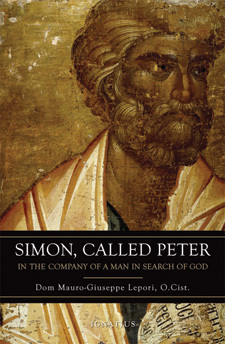 It may seem curious that there are only a handful of books on the Apostle Peter, and that
Simon Called Peter
,
It may seem curious that there are only a handful of books on the Apostle Peter, and that
Simon Called Peter
,by Dom Mauro-Giuseppe Lepori, O.Cist., is the only one available
through Ignatius Press. Given that we have very little reliable and
historical information to work from, however, perhaps it’s not as much
of a surprise as anticipated. What we do know, however, is
life-altering.
Lepori’s biography of the first Pope is unlike any other. Focusing
solely on Scripture, he weaves brief meditations on Peter’s life.
Reading Scripture, most people cannot help but view Peter as a
monumental saint, as someone who sinned once or twice, but was
overpoweringly the strong incarnation of the “Rock” Christ proclaims him
to be. But in this brief book, the author brings Peter’s personality
and humanity to the forefront.
Peter’s story, told so intuitively in this book, is something every
Christian can relate to. We see ourselves in him: Peter’s tale
presented in Scripture is the quintessential Christian biography.
Accompanying this Apostle on his own journey to Christ, and seeing him
as a man who shares our human struggles, gives us immense hope and,
hopefully, the courage to persevere ourselves. Lepori’s meditations in
this short yet unspeakably powerful book are something worthy of reading
over and over again. Each time, a new layer of Christ’s mysterious and
personal love for us is revealed. Simon Called Peter is also available as an e-book and audio download.
 Megan
MeganBless grew up near Dallas, Texas, and holds a Bachelor’s degree in
Music from Ave Maria University. Upon graduation in 2010, she moved to
California to work for Ignatius Press managing contracts. She is an
active member of the San Francisco Symphony Chorus, and enjoys writing
music and watching baseball.
*Employee
Pick of the Week program features savings of 40% off a book, movie, or
compact disc personally chosen and recommended by an Ignatius Press
employee. Each week, an Ignatius Press employee will select a favorite
book, movie, or other Ignatius Press product and write a few sentences
about why he/she thinks customers will enjoy the particular selection. A
short bio of the selecting employee will also be included, giving
customers a chance to learn a bit more about the people who are Ignatius
Press.
Offer ends Tuesday September 18th, 2012 at 12:00 midnight EST.
September 14, 2012
20% off the newly priced Ignatius Critical Editions

20% off the newly priced Ignatius Critical Editions
Plus, bring the new epic film Restless Heart to your area!
The Ignatius Critical Editions
represent a tradition-oriented approach to great books and classics of
world literature, as opposed to the more ideological approach of such
series as the Norton Critical Editions or Oxford World Classics.
With new editions added each season (23 volumes now), these books are
great not only for home-schoolers, but for anyone wishing to understand
the great works of Western civilization. Each volume includes excellent,
helpful introductions, annotations and critical essays, with beautiful
book designs. Plus a study guide for each book. With new low prices and
20% off this week, you'll want to stock up on these titles today!
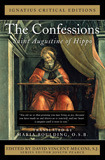 The Confessions: Saint Augustine of Hippo
The Confessions: Saint Augustine of Hippo
St. Augustine
The Confessions of Saint Augustine is considered one of the
greatest Christian classics of all time. This acclaimed new translation
by Sister Maria Boulding, O.S.B., masterfully captures his experience,
and is written in an elegant and flowing style. Her beautiful
contemporary translation of the ancient Confessions makes the classic
work more accessible to modern readers
Regular price: $14.95, sale price: $11.96
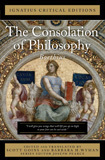 The Consolation of Philosophy
The Consolation of Philosophy
Anicius Boethius
Written in the sixth century, The Consolation of Philosophy was one
of the most popular and influential works of the Middle Ages.In the
Consolation, Boethius explores the true end of life-knowledge of
God-through a conversation with Lady Philosophy. Part prose, part
poetry, the work combines Greek philosophy and Christian faith to
formulate answers to some of life's most difficult and enduring
questions.
Regular price: $7.95, sale price: $6.36
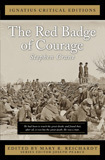 The Red Badge of Courage
The Red Badge of Courage
Stephen Crane
Stephen Crane described his novel of the American Civil War as a
"psychological portrait of fear." Although he never experienced the
horror of battle himself, Crane based his realistic narrative largely on
stories told by Civil War veterans. While those accounts tended to
focus on the external action of warfare, the young newspaper reporter
aspired to illustrate the internal experience of the soldier.
Regular price: $7.95, sale price: $6.36
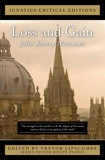 Loss and Gain
Loss and Gain
John Henry Newman
This novel about a young man's intellectual and spiritual
development was the first work John Henry Newman wrote after entering
the Roman Catholic Church in 1845. A former Anglican clergyman who was
later named a Catholic cardinal, Newman wrote this autobiographical
novel to illustrate his own reasons for embracing Catholicism.
Regular price: $9.95, sale price: $7.96
Other titles in the ICE series
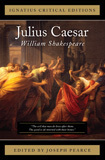 Julius Caesar
Julius Caesar
William Shakespeare
Though a staple in high school English classes, Julius Caesar is
not a simple play. Seemingly irreconcilable forces are at work: fate and
free will, the changeableness and stubbornness of ambitious men, the
demands of public service and the desire for private gain. Drawn from
history as recorded by Plutarch, the major characters-Caesar, Brutus,
Cassius, and Mark Antony-are complex, as are the twists and turns of
their fortunes.
Regular price: $5.95, sale price: $4.75
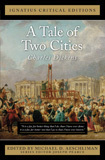 A Tale of Two Cities
A Tale of Two Cities
Charles Dickens
In this exciting novel set during the French Revolution, Charles
Dickens expresses sympathy for the downtrodden poor and their outrage at
the self-indulgent aristocracy. But Dickens is no friend of the
vengeful mob that storms the Bastille and cheers the guillotine. As with
all of his stories, his passion is for the unforgettable and
unrepeatable individuals he creates.
Regular price: $11.95, sale price: $9.56
Adventures of Huckleberry Finn
Samuel Clemens
Regular price: $9.95, sale price: $7.96
Dracula
Bram Stoker
Regular price: $11.95, sale price: $9.56
Frankenstein
Mary Shelley
Regular price: $7.95, sale price: $6.36
Great Expectations
Charles Dickens
Regular price: $11.95, sale price: $9.56
Gulliver's Travels
Jonathan Swift
Regular price: $9.95, sale price: $7.96
Hamlet
William Shakespeare
Regular price: $7.95, sale price: $6.36
King Lear
William Shakespeare
Regular price: $7.95, sale price: $6.36
Macbeth
William Shakespeare
Regular price: $5.95, sale price: $4.76
Mansfield Park
Jane Austen
Regular price: $11.95, sale price: $9.56
Moby Dick
Herman Melville
Regular price: $11.95, sale price: $9.56
Pride and Prejudice
Jane Austen
Regular price: $9.95, sale price: $7.96
Romeo and Juliet
William Shakespeare
Regular price: $5.95, sale price: $4.76
The Merchant of Venice
William Shakespeare
Regular price: $5.95, sale price: $4.76
The Picture of Dorian Gray
Oscar Wilde
Regular price: $7.95, sale price: $6.36
The Scarlet Letter
Nathaniel Hawthorne
Regular price: $7.95, sale price: $6.36
Uncle Tom's Cabin
Harriet Beecher Stowe
Regular price: $11.95, sale price: $9.56
Wuthering Heights
Emily Bronte
Regular price: $9.95, sale price: $7.96
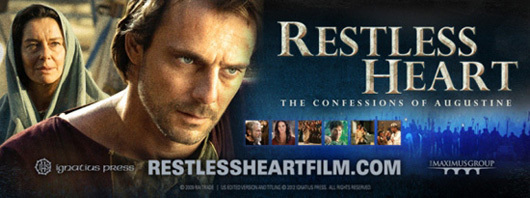
Bring this Inspiring Film about St. Augustine to a Theater Near You!
RESTLESS HEART
is the first full-length feature film on St. Augustine, one of the most
influential Doctors of the Church. Ignatius Press offers this European
production to American audiences, and it's available now for hosted
theatrical screenings.
The screenplay is based on St. Augustine's landmark work, The Confessions. RESTLESS HEART tells his story in his own words!
Join parishes and other organizations across the country who have
already booked screenings to bring this epic motion picture to their
communities.
That's right! YOU can host an exclusive screening of RESTLESS HEART ...it's easy...visit the official film website at www.RestlessHeartFilm.com to learn more and watch the trailer!
Whether you make it a night out at the movies for your parish,
organization, group - or a fundraiser - you can now bring St. Augustine
to life on the big screen!
Catholic World Report and Homiletic & Pastoral Review
A Moment of Weakness and the Paradox of God’s Grace
Targeted by extremists, a Catholic convert from Islam reflects on
the constancy that is as necessary to the Christian life as bravery.
by Ilyas Khan
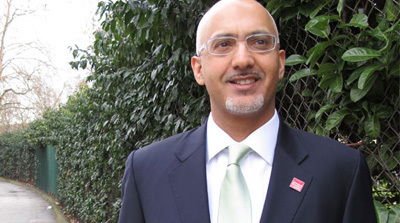
In 1980, a month or so after I had turned 18, I took up residence at
Netherhall House, an Opus Dei-run student hall in the leafy London
suburb of Hampstead.
I turned 50 in early August this year, and it is only recently that I am
able to pull off the feat of looking back across 32 years without a
sense of vertigo. The passage of time since I was 18 often seems simply a
continuation of the journey that started when I took my first steps up
the stone entrance of Netherhall and across the hushed threshold.
Shepherding the Irascible Sheep: Anger, Fear, and Fortitude
By Brother James Dominic Rooney
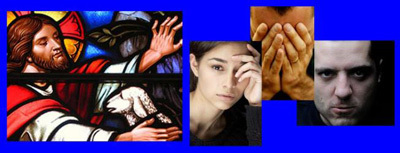
By dealing with our anger and fear in a healthy way, we develop the
virtue of fortitude (a key component of patience).Focusing on the
character of fortitude provides guidelines to dealing with clients that
encourages proper use of fear and anger without denying their existence
or validity.
The Cross is an invitation to faith, to life, and to love
On the Readings for the Feast of the Exaltation of the Holy Cross | Carl E. Olson
Readings:
• Nm 21:4b-9
• Ps 78:1bc-2, 34-35, 36-37, 38
• Phil 2:6-11
• Jn 3:13-17
“By its elevation, the Cross is like an appeal to the whole
creation to adore the blessed Passion of Christ our God who was suspended on
it, for Christ destroyed by this Cross the one who had destroyed us.”
These words, from the Vespers celebrated on this feast day
by Byzantine Catholics, proclaim some of the mystery, hope, and paradox of the
Holy Cross. There is the mystery of the death of the God-man, the hope of
salvation because of His death and Resurrection, and the paradox of finding joy
in such a bloody reality. In the words of the Crucified One, prior to His
ascent onto the Cross: “And when I am lifted up from the earth, I will draw
everyone to myself” (Jn 12:32).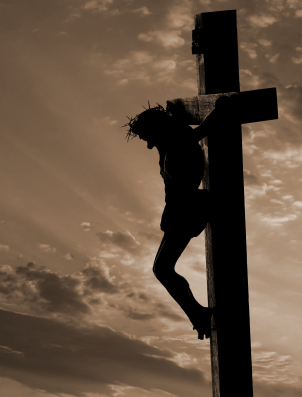
Today’s Epistle and Gospel readings focus on the
relationship between the Incarnation—the entrance of God into history as the
man Jesus Christ—and the exaltation of the Incarnate One by His death on the
Cross. That relationship is, of course, at the heart of Christianity, for
belief in the Incarnation and the salvific work accomplished on the cross are
central for Christians. If Jesus was not truly God and truly man, Christianity
is simply another school of ethics; if the Passion and Resurrection did not
take place, Catholicism is merely a ritualized exercise in empty piety.
The reading from Paul’s Epistle to the Philippians is a
great Christological hymn offered in thanksgiving for the Incarnation. Although
the Son was equal to the Father, He emptied Himself. What does that mean? Much
scholarly ink has been spilled over this difficult theological question, but
the essence of this emptying, or kenosis,
is the perfect acceptance of God’s will. The willingness of the Son to be sent
by the Father for the salvation of man is a major theme in the Gospel of John.
“You know me and also know where I am from,” Jesus declared in the Temple, “Yet
I did not come on my own, but the one who sent me, whom you do not know, is
true” (Jn 7:28).
This can also be seen in the third chapter of John, in which
Jesus states that God “gave his only Son” and sent His Son into the world so
“the world might be saved through him.” In that same discourse to Nicodemus,
Jesus stated that no one has gone up to heaven except the one who has come
down. This is one of many claims to divinity made by Jesus, who foretold His
death, Resurrection, and Ascension, even as He revealed that He had been sent
by and from the Father in heaven.
This raises a significant point about the Cross: it is not a sign of God’s
wrath, but a concrete demonstration of His love for man. The Romans used the
cross to punish, kill, and control. God used the altar of the Cross to forgive,
to destroy death, and to offer eternal life. “Accordingly, in the New Testament
the Cross appears primarily as a movement from above to below,” wrote Joseph
Ratzinger in Introduction to Christianity,
“It stands there, not as the work of expiation that mankind offers to the
wrathful God, but as the expression of that foolish love of God’s that gives
itself away to the point of humiliation in order thus to save man; it is his approach to us, not the other way about.”
The Cross, then, is an invitation to faith, to life, to
love. It is a revelation of the nature of God. It is also a sign of
contradiction and a source of scandal. This is what Jesus meant when He spoke
of being lifted up. I know people who, when they see a crucifix, are disgusted
and appalled. I also know a young lady who, after being an atheist for several
years, finally crumbled on her knees before a crucifix and wept, broken and
healed.
“We exalt his Name with great rejoicing,” continue the
Vespers, “and glorify his infinite condescension.” Amen!
(This "Opening the Word" column originally appeared in the September 14, 2008, edition of Our Sunday Visitor newspaper.)
The Question of Suffering, the Response of the Cross

The Question of Suffering, the Response of the Cross | Joseph Cardinal Ratzinger
An excerpt from God
and the World: A Conversation with Peter Seewald (Ignatius Press, 2002), by Joseph Cardinal
Ratzinger, pages 332-36, 333.
Seewald: We are used to thinking of suffering as something we try to
avoid at all costs. And there is nothing that many societies get more angry
about than the Christian idea that one should bear with pain, should endure
suffering, should even sometimes give oneself up to it, in order thereby
to overcome it. "Suffering", John Paul II believes, "is a part of the mystery
of being human." Why is this?
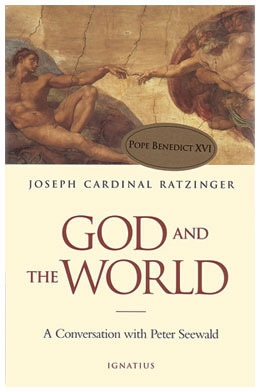
Cardinal Ratzinger: Today what people have in view is eliminating suffering
from the world. For the individual, that means avoiding pain and suffering
in whatever way. Yet we must also see that it is in this very way that the
world becomes very hard and very cold. Pain is part of being human. Anyone
who really wanted to get rid of suffering would have to get rid of love
before anything else, because there can be no love without suffering, because
it always demands an element of self-sacrifice, because, given temperamental
differences and the drama of situations, it will always bring with it renunciation
and pain.
When we know that the way of love–this exodus, this going out of oneself–is
the true way by which man becomes human, then we also understand that suffering
is the process through which we mature. Anyone who has inwardly accepted
suffering becomes more mature and more understanding of others, becomes
more human. Anyone who has consistently avoided suffering does not understand
other people; he becomes hard and selfish.
Love itself is a passion, something we endure. In love experience first
a happiness, a general feeling of happiness.
Yet on the other hand, I am taken out of my comfortable tranquility and
have to let myself be reshaped. If we say that suffering is the inner side
of love, we then also understand it is so important to learn how to suffer–and
why, conversely, the avoidance of suffering renders someone unfit to cope
with life. He would be left with an existential emptiness, which could then
only be combined with bitterness, with rejection and no longer with any
inner acceptance or progress toward maturity.
Seewald: What would actually have happened if Christ had not appeared
and if he had not died on the tree of the Cross? Would the world long since
have come to ruin without him?
Cardinal Ratzinger: That we cannot say. Yet we can say that man would
have no access to God. He would then only be able to relate to God in occasional
fragmentary attempts. And, in the end, he would not know who or what God
actually is.
Something of the light of God shines through in the great religions of the
world, of course, and yet they remain a matter of fragments and questions.
But if the question about God finds no answer, if the road to him is blocked,
if there is no forgiveness, which can only come with the authority of God
himself, then human life is nothing but a meaningless experiment. Thus,
God himself has parted the clouds at a certain point. He has turned on the
light and has shown us the way that is the truth, that makes it possible
for us to live and that is life itself.
Seewald: Someone like Jesus inevitably attracts an enormous amount of attention and
would be bound to offend any society. At the time of his appearance, the
prophet from Nazareth was not only cheered, but also mocked and persecuted. The
representatives of the established order saw in Jesus' teaching and his person
a serious threat to their power, and Pharisees and high priests began to seek
to take his life. At the same time, the Passion was obviously part and parcel
of his message, since Christ himself began to prepare his disciples for his
suffering and death. In two days, he declared at the beginning of the feast of
Passover, "the Son of Man will be betrayed and crucified."
Cardinal Ratzinger: Jesus is adjusting the ideas of the disciples to the fact that the Messiah is
not appearing as the Savior or the glorious powerful hero to restore the renown
of Israel as a powerful state, as of old. He doesn't even call himself Messiah,
but Son of Man. His way, quite to the contrary, lies in powerlessness and in
suffering death, betrayed to the heathen, as he says, and brought by the
heathen to the Cross. The disciples would have to learn that the kingdom of God
comes into the world in that way, and in no other.
Seewald: A world-famous picture by Leonardo da Vinci, the Last Supper, shows Jesus' farewell meal in
the circle of his twelve apostles. On that evening, Jesus first of all throws
them all into terror and confusion by indicating that he will be the victim of
betrayal. After that he founds the holy Eucharist, which from that point onward
has been performed by Christians day after day for two thousand years.
"During the meal," we read in the Gospel, "Jesus took the bread
and spoke the blessing; then he broke the bread, shared it with the disciples,
and said: Take and eat; this is my body. Then he took the cup, spoke the
thanksgiving, and passed it to the disciples with the words: Drink of this, all
of you; this is my blood, the blood of the New Covenant, which is shed for you
and for many for the forgiveness of sins. Do this in remembrance of me."
These are presumably the sentences that have been most often pronounced in the entire
history of the world up till now. They give the impression of a sacred formula.

Cardinal Ratzinger: They are a sacred formula. In any
case, these are words that entirely fail to fit into any category of what would
be usual, what could be expected or premeditated. They are enormously rich in
meaning and enormously profound. If you want to get to know Christ, you can get
to know him best by meditating on these words, and by getting to know the context
of these words, which have become a sacrament, by joining in the celebration.
The institution of the Eucharist represents the sum total of what Christ Is.
Here Jesus takes up the essential threads of the Old Testament. Thereby he
relies on the institution of the Old Covenant, on Sinai, on one hand, thus
making clear that what was begun on Sinai is now enacted anew: The Covenant
that God made with men is now truly perfected. The Last Supper is the rite of
institution of the New Covenant. In giving himself over to men, he creates a
community of blood between God and man.
On the other hand, some words of the prophet Jeremiah are taken up here,
proclaiming the New Covenant. Both strands of the Old Testament (Law and
prophets) are amalgamated to create this unity and, at the same time, shaped into
a sacramental action. The Cross is already anticipated in this. For when Christ
gives his Body and his Blood, gives himself, then this assumes that he is
really giving up his life. In that sense, these words are the inner act of the
Cross, which occurs when God transforms this external violence against him into
an act of self-donation to mankind.
And something else is anticipated here, the Resurrection. You cannot give anyone
dead flesh, dead body to eat. Only because he is going to rise again are his
Body and his Blood new. It is no longer cannibalism but union with the living,
risen Christ that is happening here.
In these few words, as we see, lies a synthesis of the history of
religion—of the history of Israel's faith, as well as of Jesus' own being
and work, which finally becomes a sacrament and an abiding presence. ...
Seewald: The soldiers abuse Jesus in a way we can hardly imagine. All
hatred, everything bestial in man, utterly abysmal, the most horrible things
men can do to one another, is obviously unloaded onto this man.
Cardinal Ratzinger: Jesus stands for all victims of brute force. In the
twentieth century itself we have seen again how inventive human cruelty
can be; how cruelty, in the act of destroying the image of man in others,
dishonors and destroys that image in itself. The fact that the Son of God
took all this upon himself in exemplary manner, as the "Lamb of God", is
bound to make us shudder at the cruelty of man, on one hand, and make us
think carefully about ourselves, how far we are willing to stand by as cowardly
or silent onlookers, or how far we share responsibility ourselves. On the
other side, it is bound to transform us and to make us rejoice in God. He
has put himself on the side of the innocent and the suffering and would
like to see us standing there too.
Related IgnatiusInsight.com Articles and Book Excerpts:
• Author Page for Joseph Ratzinger/Pope Benedict XVI
• The Truth of the Resurrection |
Excerpts from Introduction to Christianity | Joseph Cardinal Ratzinger
• Seeing Jesus in the Gospel of John |
Excerpts from On The Way to Jesus Christ | Joseph Cardinal Ratzinger
• God Made Visible |
A Review of On The Way to Jesus Christ | Justin Nickelsen
• A Shepherd Like No Other |
Excerpt from Behold, God's Son! | Christoph Cardinal Schönborn
• Encountering Christ in the Gospel |
Excerpt from My Jesus | Christoph Cardinal Schönborn
• A Jesus Worth Dying For |
On the Foreword to Benedict XVI's Jesus of Nazareth | Fr. James V. Schall, S.J.
• The Divinity of Christ | Peter Kreeft
• Jesus Is Catholic | Hans Urs von Balthasar
• The Religion of Jesus | Blessed Columba Marmion
| From Christ, The Ideal of the Priest
• Studying The Early Christians | The Introduction to We
Look For the Kingdom: The Everyday Lives of the Early Christians | Carl J. Sommer
• The Everyday Lives of the Early Christians | An interview with
Carl J. Sommer
Joseph Ratzinger, now Pope Benedict XVI, was for over two decades
the Prefect for the Congregation of the Doctrine of the Faith under Pope
John Paul II. He is a renowned theologian and author of numerous books.
A mini-bio and full listing of his books published by Ignatius Press are
available on his IgnatiusInsight.com
Author Page.
September 13, 2012
Canada: Ignored, Mysterious, and Very Confused

Canada: Ignored, Mysterious, and Very Confused | Michael Coren | Catholic World Report
The first installment of a new column, “Controversies with Coren”
It’s
always a challenge to write a first column, to introduce oneself to a new
audience. My brief is to cover pretty much anything I want, but to write about
Canada and Britain in particular. The reason is that I spent the first half of
my life in London, the second in Toronto. I married a Canadian. We met at a G.K.
Chesterton conference in 1986, where I delivered a startlingly boring lecture
entitled “Chesterton, Belloc, the Marconi Scandal, and Edwardian Anti-Semitism.”
Not a usual subject for future wife attraction, but even so this highly
intelligent, extraordinarily beautiful woman approached me at a cocktail party
at the end of the conference and exclaimed, “You’re amazing.” She was doubtless
drunk.
Thinking
this would never happen again, I married her. And I was right: it hasn’t
happened again, and as far as I can recall she hasn’t said it again either.
Thus
Canada, which is one of those geopolitical mysteries. Like Costa Rica’s
peacefulness or the beauty of Bruges. People just don’t usually know. Thirty
million inhabitants, incredibly wealthy, absurdly large, enormously successful,
culturally and artistically fertile, and often a predictor of what the USA will
become 10 years later. But because it’s a former British colony and on top of
the world’s only superpower it’s often forgotten, ignored. Frankly, it rather
likes it that way. Similarly with the Canadian Church. There are more than 13
million Catholics in Canada, 44 percent of the population. There are eight million
Protestants of various denominations, the largest claiming to be the United
Church, at around half-a-million members.
It’s
the most liberal of the churches and is hemorrhaging adherents. As are the
Anglicans and the Presbyterians. Unlike in the US, Evangelicals at around 11
percent are not a major force. Immigration has, of course, enormously increased
the Hindu, Sikh, and, in particular, Muslim communities.
There
is an extensive and publicly funded Catholic education system in the country, a
tiny but still permitted Catholic television station, and in the past two
generations it’s been unusual to have a prime minister who is not Catholic. Of
a sort.
Carl E. Olson's Blog
- Carl E. Olson's profile
- 20 followers



